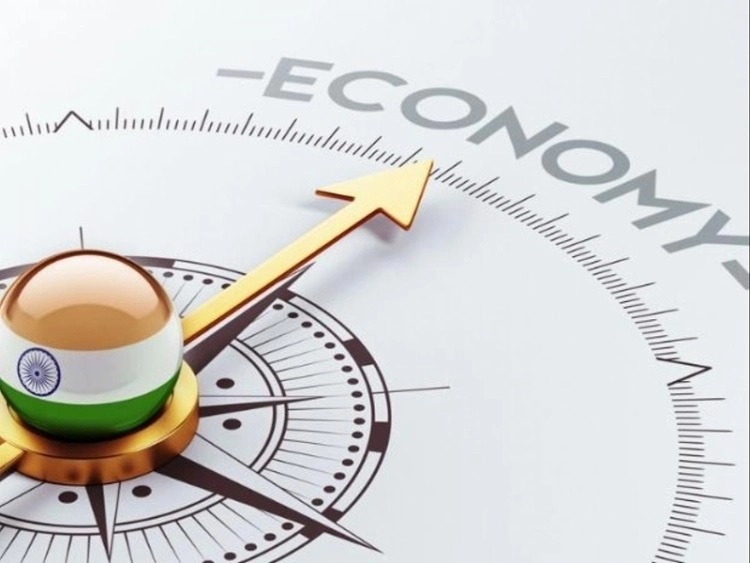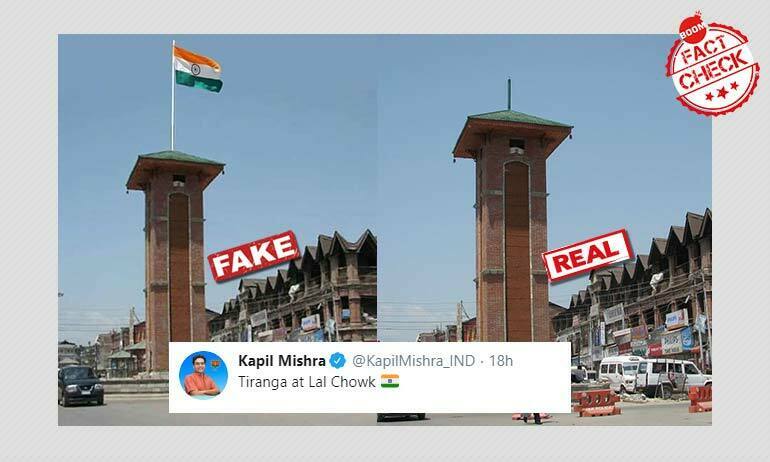
As basic journalistic practice of fact-checking is increasingly losing its foothold in many Indian newsrooms, the Kashmir Valley is unabatedly facing the fake news offensive. The malicious practice is only misrepresenting the ground reality with a clear intent.
By Arshi Qureshi
ON the day when Prime Minister Narendra Modi was talking about the sweeping “development” in the Kashmir valley from the ramparts of Red Fort, social media was abuzz with the viral image of Srinagar’s Lal Chowk, whose iconic clock tower was seen flying tricolor.
The image took the confined natives by surprise as the photo showed public movement apart from the unfurled flag on the day when the city centre had become a ghost town.
Apart from some top BJP leaders, including Kapil Mishra and Kirron Kher, the peddlers of this distorted image were some well-known Indian newsrooms.
“On the occasion of India’s 74th Independence Day,” a Dainik Jagran report claimed, “the tricolour was reportedly hoisted at the historic Lal Chowk in Srinagar.” Lal Chowk used to see bloodshed due to hoisting of the national flag, a report by News Nation said. “Now the country’s flag rises there with pride.”
But soon, the fake news peddlers faced some moment of truth when a freelance journalist—whose photo-shopped photo was used for peddling the fake news—countered the newsroom claims. “Have you no shame in sharing a doctored image? I clicked the original photo without the Indian flag on June 22, 2010. #LalChowk #FakeNews #Fakeimage,” tweeted photojournalist Mubasshir Mushtaq.
Have you no shame in sharing a doctored image? I clicked the original photo without the Indian flag on June 22, 2010. @SMHoaxSlayer @AltNews @boomlive_in @free_thinker #LalChowk #FakeNews #Fakeimage https://t.co/25FtKivTft
— مبشر مشتاق Mubasshir Mushtaq (@MubasshirM) August 15, 2020
Just Another Distortion
Although the valley has been facing the fake news blitz for decades now, the intensity has clearly increased since 2019. As soon as Jammu and Kashmir was stripped of its special status last summer, the internet and the electronic media were flooded with fake news. Some of the news anchors of the so-called ‘Godi’ media allegedly turned PR gurus and disinformation peddlers.
But 24 hours after the propaganda around Article 370, and 35A was spread, some prominent fact-checkers busted the fake news factory.
Speaking about the Indian media’s fake portrayal of Kashmir, the Alt News (a leading fact-checking website) founding editor, Pratik Sinha, questioned the definition of ‘newsroom normalcy’ for Kashmir.
“What’s normalcy? Children of Kashmir are growing up in a conflict area. Is this normal? As means of communication is normal, then how do you define normalcy for a common man in Kashmir?”
It was, in fact, Sinha’s Alt News, which debunked the misinformation when PM Modi misquoted Omar Abdullah in the Parliament. The misinformation spread on February 6, 2020 was picked up by various TV news channels.
But soon, a fact-finding revealed that PM had quoted a parody website called ‘Faking News’—which had attributed a spoof quote to Abdullah Jr: “The abrogation of Article 370 would bring a massive earthquake that will divide Kashmir from India.”
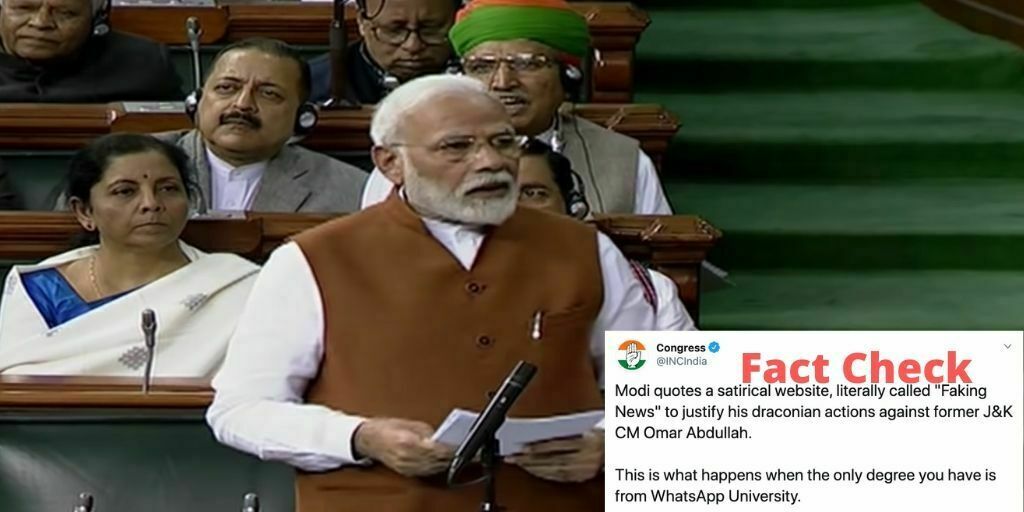
But before the house would only fuel the fake news crisis in contemporary India, many New Delhi-based media houses had taken a contrasting line from international media on Kashmir last summer.
In fact, when facts countered fiction, the Ministry of Home Affairs had to issue a statement on twitter, claiming that international media’s reportage—claiming that 10,000 people protested against the abrogation of Article 370 in downtown south—is ‘fabricated’ and ‘incorrect’.
A news report originally published in Reuters and appeared in Dawn claims there was a protest involving 10000 people in Srinagar.
This is completely fabricated & incorrect. There have been a few stray protests in Srinagar/Baramulla and none involved a crowd of more than 20 ppl.
— Spokesperson, Ministry of Home Affairs (@PIBHomeAffairs) August 10, 2019
Exactly three days later on August 13, 2019, the Home Ministry again tweeted out a clarification calling the protests “miscreants mingled with people returning home after prayers at a local mosque. They resorted to unprovoked stone-pelting against law enforcement forces to cause widespread unrest”.
Republic TV’s Editor-in-Chief Arnab Goswami on his prime time debate dismissed the western media’s Kashmir coverage as fake news. The aggressive anchor known for his tirade of abuse went on to accuse the BBC of spreading false propaganda. “Don’t run away from me now, BBC! The figures you have peddled about, what was the proof gathered from?”
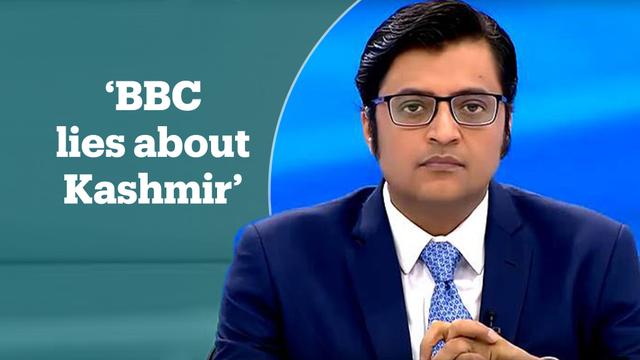
Channels like Times Now and India Today weren’t far behind. Soon they started holding debates on ‘normalcy in Kashmir’ regularly. While the primetime news anchors were boasting how people in Kashmir were happy, ANI, Asian News International, which is often regarded as the ‘government’s mouthpiece’, went a step further and showed Eid prayers being offered in a mosque in Srinagar, when the footage was originally from Jammu.
Another interesting piece of fake news was when newsrooms showed Mohammed Ashraf Azad as a local Kashmiri supporting the government’s abrogation move. What they didn’t report was that this local Kashmiri is a BJP leader.
Why They Distort
“Well, because, most of these journalists, who reported from the ground, are quite close to the government, and their work is to push pro-government propaganda,” Pratik Sinha told Kashmir Observer.
Many believe New Delhi pressed hard to emphasize normalcy in the valley and the media pushed it harder. With the result, majority of Indians in their living rooms stared at their TV screens and rejoiced over ‘Kashmir Integration’ and at the same time remained oblivious of the ground reality.
“That way,” a Srinagar-based scribe said, “the government media was successful in hiding the dark reality, in which Kashmir was passing through.”
Even the print media followed suit.
Behind the big and bold headlines—“Mission Kashmir Victory” by Times of India, “Territory of the Union” by Hindustan Times and “History, In One Stroke” by the Indian Express—the grouse on the ground remains that these traditionalists conveniently concealed the crisis in the valley.
“Even these major and popular English newspapers became the part of selective coverage by focussing on Eid prayers,” the scribe continued.
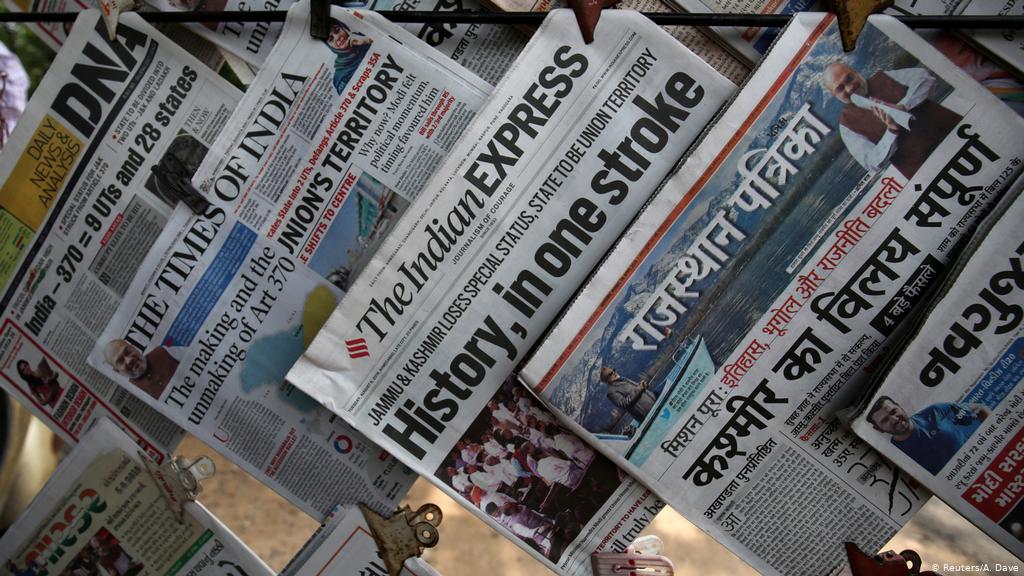
Amid fake news bombardment, the plight of Kashmiris due to communication crisis was largely ignored.
“It’s an injustice to the word ‘media’ and to the word ‘journalism’ to describe large sections of Indian televisions media, they’re glorified stenographers who propagate the ideology of ruling dispensation,” Gowhar Geelani, a Srinagar-based journalist, said.
“They’re parachuted to portray Kashmir’s pain, disposition as normalcy. This practice didn’t start on August 5, this has been done over the last thirty years but it got only worse and intense. It’s ugly face became more visible on August 5.”
When questioned about the role of the International media, Geelani stated the international media do not carry this baggage of ideology. “They present the ground reality and talk to locals,” he said. “It is reflected in their reports. When local Kashmiri media reported the clashes, many Kashmiri editors were taken away by NIA for questioning in Delhi.”
Many in mainland argue that the media distortion often happens in the name of “national interest and patriotism”.
“Since many in India see Kashmir as a land of pride they possess, they refuse to acknowledge the miseries of Kashmiris,” said Abhishek Sharma, a Delhi-based journalist. “Kashmir is considered to be the largest military zone in the world, but the Indian media refuses to show it and chides the International media for covering the truth.”

New Delhi based media basks in its own glory while reporting about Kashmir, Sharma said. “The misrepresentation of the valley is no less than disinformation.”
And therefore, Gowher Geelani believed, Kashmiris have no faith in such media. “They behave like Joseph Gobbel’s ministry of propaganda.”
Follow this link to join our WhatsApp group: Join Now
Be Part of Quality Journalism |
Quality journalism takes a lot of time, money and hard work to produce and despite all the hardships we still do it. Our reporters and editors are working overtime in Kashmir and beyond to cover what you care about, break big stories, and expose injustices that can change lives. Today more people are reading Kashmir Observer than ever, but only a handful are paying while advertising revenues are falling fast. |
| ACT NOW |
| MONTHLY | Rs 100 | |
| YEARLY | Rs 1000 | |
| LIFETIME | Rs 10000 | |





